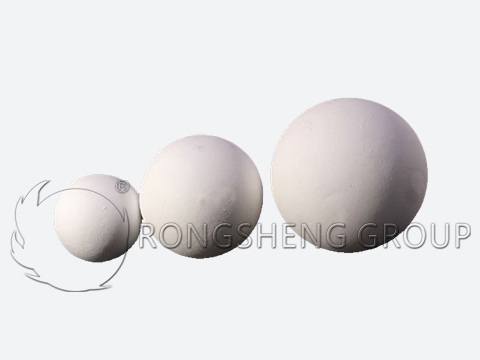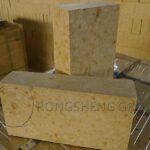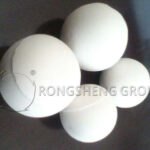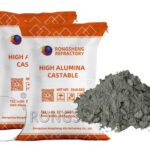Alumina ceramic balls are made of alumina with very low silicon content and have high purity and strength, making them extremely resistant to high temperatures. Used in reaction towers to prevent equipment covered by filtered silica from forming fouling or damaging the catalyst carrier.
Advantages of Alumina Ceramic Balls
- High Wear Resistance. The wear resistance of alumina ceramic balls is better than that of ordinary ceramic balls. When the grinding ceramic ball is running, it does not produce pollution, so it can maintain high purity and improve the stability of the grinding effect.
- High Density. High density, high hardness and high grinding characteristics save grinding time, expand the grinding space, and can effectively improve the grinding effect.

Alumina ceramic balls are a kind of ceramic filler produced mainly from alumina materials. This type of product is available in various sizes and purity and is used as covering support material and tower packing for the catalyst in the reactor. Zirconia beads-alumina ceramic balls have the characteristics of high temperature and high pressure resistance, low water absorption and stable chemical properties. It can withstand the corrosion of acids, alkalis and other organic solvents, and can withstand temperature changes that occur during the production process. Its main function is to increase gas or liquid distribution points, support and protect active catalysts with low strength.
Professional manufacturer of zirconia beads, high alumina balls, inert ceramic balls, alumina ceramic lining bricks, and wear-resistant ceramic linings.
The Application Effect of Alumina Ceramic Balls in the Industry
Nano-alumina ceramic balls can further improve the performance of ceramics. It has wide applications in the following fields.
- Ceramic additives. Adding a certain amount of nanoscale spherical alumina powder can effectively solve the shortcomings of ceramics’ narrow application range due to low-temperature brittleness. Low-temperature plastic spherical alumina ceramics can thus be produced. Adding 5.0% nanoscale alumina powder to conventional ceramics can effectively increase the toughness of the ceramic and reduce the sintering temperature of the ceramic.
- Composite materials. Nanoscale alumina powder can not only be used to synthesize new composite ceramic materials with special properties as well as aluminum alloy nanospherical alumina composite materials. It can also be used to make artificial teeth and bones.
- Dispersion strengthening materials. Alumina is often used as a dispersed phase in structural materials to enhance the strength of the base material. The yield stress of a material is inversely proportional to the spacing of dispersed particles. That is, the smaller the distance between particles, the greater the yield strength. When the content of the dispersed phase is constant, the smaller the particles, the smaller the distance between particles, and the more beneficial it is to improve the yield strength of the material. Dispersing ultrafine aluminum oxide in metal can improve the strength of the metal. During casting, nano-spherical alumina powder is used as the nucleus for metamorphosis. The powder itself has no strengthening phase, and the wear resistance can be improved several times.
- Surface protective coating. Nano-aluminum oxide particles can be made into a transparent coating that can be sprayed on glass, plastic, metal, lacquer and even polished marble. It can greatly improve the surface hardness, corrosion resistance, wear resistance and fire resistance. Therefore, it can be used for surface protection of machinery, cutting tools and chemical pipelines.
- Optical materials. Nanoscale alumina powder has strong absorption ability for ultraviolet light below 250nm. If a few nanometers of alumina powder are doped into rare earth phosphors, the blue shift phenomenon of nanometer ultraviolet absorption can be used to absorb harmful ultraviolet light without reducing the luminous efficiency of the phosphors. Nano-alumina can be sintered into transparent ceramics as materials for high-pressure sodium lamps, and can be compounded with rare earth phosphors as luminescent materials for oral light lamps. It not only reduces costs but also extends lifespan, making it the main fluorescent material for manufacturing mouth light tubes in the future.
- Semiconductor materials. Nanoscale spherical alumina is extremely sensitive to humidity and has extremely high application value in humidity sensors. In addition, it can also be widely used as substrate material for large-scale integrated circuits.
- Catalyst and its carrier. Nano-alumina powder has a large specific surface area, and the particle surface is extremely rich in mismatch bonds and oxygen-deficient bonds. When pressed into thin sheets, it will contain abundant holes, with a porosity rate of 30-40%, and can be made into porous membrane filters. The performance of the catalyst and catalyst carrier made in this way is several times better than that of similar products currently used.
Nano-spherical alumina ceramic balls are widely used in traditional industries, such as light industry, chemical industry, building materials, etc. As well as high-tech fields such as new materials, microelectronics, and aerospace industry, its application prospects are very broad. The annual growth rate of demand for ultrafine spherical alumina in domestic and foreign markets continues to increase. Therefore, it is of great significance to further explore new methods for preparing ultrafine spherical alumina powder.








